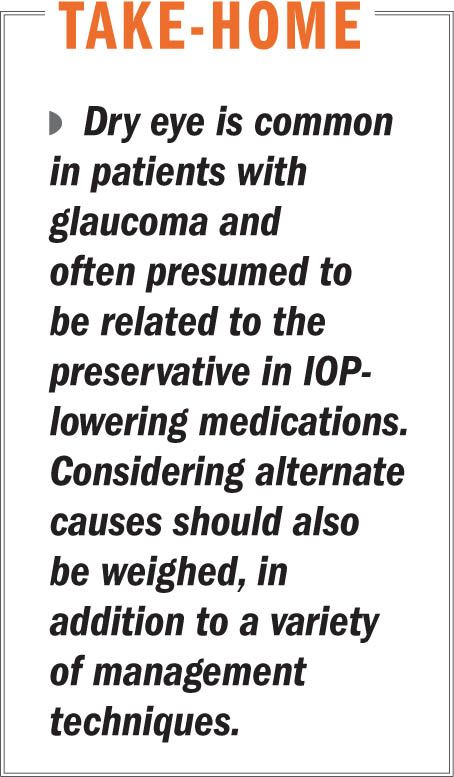Article
Addressing ocular surface toxicity in glaucoma patients
Dry eye is common in patients with glaucoma and often presumed to be related to the preservative in IOP-lowering medications. Considering alternate causes should also be weighed, in addition to a variety of management techniques.
Reviewed by Nathan M. Radcliffe, MD
New York-Ocular surface disease is a common finding in patients using topical IOP-lowering medications. Because clinicians often attribute this problem to benzalkonium chloride toxicity, switching the patient’s therapy to a product that contains a “gentler” preservative or no preservative is a frequently employed solution.

However, strategies for minimizing ocular surface issues associated with chronic topical medications should also consider whether the active ingredient itself might be the culprit and, as a basic principle, aim to minimize total drop exposure, said Nathan M. Radcliffe, MD.
Recent: How cataract surgery may benefit certain PAC/PACG patients
“About half of patients with glaucoma have signs and symptoms of dry eye, and so this is truly an issue that cannot be ignored,” said Dr. Radcliffe, director of glaucoma service and assistant professor of ophthalmology, Weill Corneal Medical College, New York. “Furthermore, there is clear evidence at least from basic science research to support the idea that toxicity from preservatives and particularly BAK plays a role in ocular surface disease in patients with glaucoma.”
More glaucoma: What astronauts can teach us about glaucoma
However, it is important to rule out whether the signs and symptoms are manifestations of a reaction to the active ingredient and to consider whether medical treatment can be eliminated altogether, and if not, how to use as few drops as possible, he noted.
The medication molecule
Dr. Radcliffe noted that prostaglandin analogues and brimonidine 0.2% can cause local reactions that can be mistaken for preservative-induced ocular surface toxicity.
More: What is the non-clinical effect of pediatric glaucoma?
Prostaglandin analogues can be associated with hyperemia, while there is about a 20% rate of allergic reaction to brimonidine in patients using the 0.2% formulation. The features of this type IV hypersensitivity reaction include hyperemia along with blepharitis and follicular conjunctivitis. Resolution is achieved only by stopping the medication.
Decreasing drop burden
Decreasing drop burden
In order to minimize preservative exposure, clinicians should cling to monotherapy and use the most effective medications for initial and add-on therapy, choosing a fixed combination whenever possible if dual therapy is necessary.
If a patient presents with a very inflamed ocular surface after being on three or four topical medications for some time, it can be almost impossible to identify what medication or medications is causing the problem.
More: Laser therapy addresses bilateral glaucoma in single treatment
In this situation, Dr. Radcliffe recommends stopping all topical medications and switching to an oral carbonic anhydrase inhibitor (acetazolamide, methazolamide) to give the ocular surface a holiday. Once the ocular surface condition is improved and while the patient is maintained on oral therapy, topical medication can be reintroduced slowly in a stepwise fashion, recognizing that perhaps the patient did not need to be on so many medications.
A good choice for initiating therapy is timolol maleate 0.5%, Dr. Radcliffe said.
“Of all the IOP-lowering medications, timolol maleate 0.5% is probably the gentlest to the ocular surface. Furthermore, a literature review I conducted found that rates of hyperemia with prostaglandin analogues and brimonidine allergy were lower when those medications were used in a fixed-combination containing timolol maleate than with alone as monotherapy,” he noted.
Related: Weighing pros, cons of IOL implantation in pediatric cataract
When rebuilding therapy, it is also worthwhile to consider formulations that have a low concentration of BAK [Lumigan 0.03%, Allergan], are preservative-free [Timoptic in Ocudose, Bausch + Lomb; Zioptan, Merck] or contain novel preservatives [Alphagan P, Allergan; Travatan Z, Alcon]. Alternatively, laser trabeculoplasty or cataract surgery with a minimally invasive glaucoma surgery procedure may be effective for reducing or eliminating the burden of medications.
“There is no question that when it comes to ocular surface health, laser trabeculoplasty has a clear advantage over topical medications. From that perspective, it might make sense to offer laser as primary treatment for all patients, and some glaucoma specialists do,” Dr. Radcliffe said.
“I find, however, that most patients are more comfortable starting treatment with topical therapy.”
Treating dry eye
Treating dry eye
Whether or not to use topical cyclosporine A 0.05% (Restasis, Allergan) to treat dry eye in patients with glaucoma on topical medications is a controversial issue. Dr. Radcliffe said that although cyclosporine is the only available topical medication that has been proven in a randomized controlled trial to improve dry eye signs and symptoms, glaucoma specialists are often reluctant to use it for fear that adding another medication to the patient’s regimen will interfere with their glaucoma medication adherence.
More dry eye: Tear volume–a neglected issue?
“That is a valid concern, but the other side of the coin is that I have seen treatment with topical cyclosporine make a huge positive difference in the signs and symptoms of dry eye in glaucoma patients,” Dr. Radcliffe said. “Therefore, it is important to be thoughtful in weighing the benefits and risks for patients on an individual basis.”
The issues to consider are whether the toxicity can be addressed by modifying the glaucoma regimen, if the glaucoma medication is an exacerbating factor for the dry eye rather than the root cause, and if the need to use another medication is likely to affect the patient’s adherence to the glaucoma medication regimen.
Related: How sleep patterns may affect MGD, dry eye
Nathan M. Radcliffe, MD
Dr. Radcliffe is a speaker and/or consultant for Alcon Laboratories, Allergan, Carl Zeiss Meditec, Iridex, and Merck.
Newsletter
Don’t miss out—get Ophthalmology Times updates on the latest clinical advancements and expert interviews, straight to your inbox.




